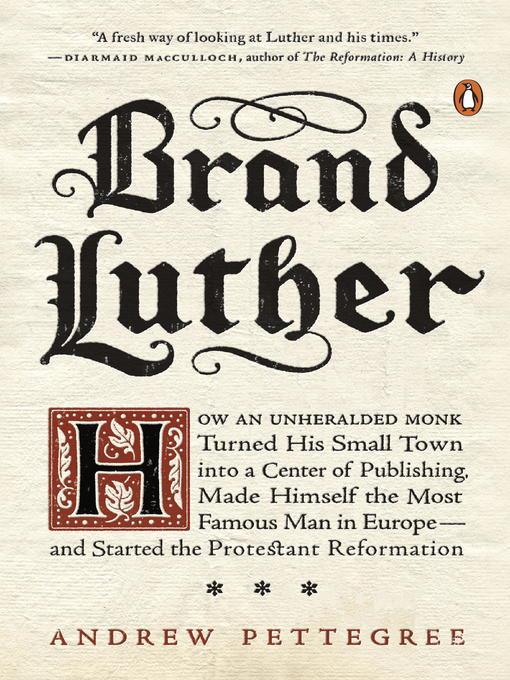
Brand Luther
How an Unheralded Monk Turned His Small Town into a Center of Publishing, Made Himself the Most Famous Man in Europe--and Started the Protestant Reformation
کتاب های مرتبط
- اطلاعات
- نقد و بررسی
- دیدگاه کاربران
نقد و بررسی

August 31, 2015
British historian Pettegree (The Invention of News), professor of modern history at the University of St. Andrews, Scotland, takes a new look at 16th-century theologist Martin Luther and how his complaints against Rome might have been ignored were it not for their dissemination through the new invention of the printing press. Pettegree follows Luther’s career not from the point of view of theology and reform, but as a masterfully managed use of technology by a savvy promoter. Luther understood how printing worked; to get his message to the general public, he wrote clear, short pamphlets in German that could be printed and sold locally within a few days. Pettegree emphasizes the importance of Luther’s innovations to publishing, including his collaboration with artist and entrepreneur Lucas Cranach, who designed Luther’s frontispieces and carved woodcuts of the author. Luther’s copious writings, in both German and Latin, made him the most published author in Europe; he also autographed books and wrote glowing recommendations for other reformers. Pettegree notes that Catholic refutations of Luther existed but were printed less because “those of Luther’s supporters sold much better.” Readers with experience in publishing will be amazed by how little has changed.

August 15, 2015
Anticipating the 500th anniversary of the Reformation, Royal Historical Society vice president Pettegree (Modern History/Univ. of St. Andrews; The Invention of News: How the World Came to Know About Itself, 2014, etc.) offers a cogent and authoritative overview of Martin Luther (1483-1546) and of the burgeoning printing industry that disseminated his ideas. Railing against clerical corruption, Luther gained renown through his prolific writings. Pettegree contends that Luther "invented a new form of theological writing: short, clear, and direct, speaking not only to his professional peers but to the wider Christian people." In 1517, when Luther posted his 95 theses on the door of the Wittenberg church-a common place for announcements to the community-he was an unknown monk who had rarely published. His document, harshly critical of the selling of indulgences that duped Christians into believing they could buy salvation, was widely circulated; "thanks to print," the author contends, "the indulgence controversy" became "a public matter." Four years later, after publishing prolifically, Luther was declared a heretic and excommunicated. By the time he died, he was a bestselling author whose works included anti-Semitic (On the Jews and Their Lies) and violently abusive tracts. Pettegree attributes Luther's fame both to his ideas and-a bit repetitiously-to his shrewd use of publishing. Although he acknowledges that "a large proportion of the population could not read, even in relatively sophisticated urban societies such as the German imperial cities," readership among the clergy and intelligentsia was enough to warrant massive printings of Luther's pamphlets, catechisms, and vernacular translation of the Bible. His friend and ally the artist Lucas Cranach designed attractive title pages highlighting Luther's name, an innovation that contributed to the creation of what Pettegree calls "Brand Luther." An informative history of a man of "adamantine strengths and...very human weaknesses" who incited a theological revolution.
COPYRIGHT(2015) Kirkus Reviews, ALL RIGHTS RESERVED.

September 15, 2015
Many biographies of Protestant reformer Martin Luther (1483-1546) deserve attention, with Roland Bainton's Here I Stand authoritatively at the front of the line. What sets this volume from Pettegree (modern history, Univ. of St. Andrews) apart is his narrative frame: he focuses on Luther's uncanny knack for exploiting an emerging technology called the printing press to spread the Protestant gospel in 16th-century Europe. "Catechisms and prayer books, Bibles and hymnals, sermons, church orders, and commentaries"--these represent the new social media that Luther employed to bring the Gospel of Christ out of the rarified air of the clerical ranks and into the hands of everyday people. The author claims, "The Reformation could not have occurred as it did without print." This is not hagiography; Pettegree admirably presents Luther, warts and all. But in the final analysis, he asks whether printing created Luther and the Protestant Reformation or Luther created mass media through his shrewd manipulation and adaptation of the printing industry to his specific needs. This book argues both--it's hard to separate one from the other since the rising success of printing as well as Protestantism seemed to go hand in hand. VERDICT Well researched and well written, this essential book is for anyone remotely interested in Luther or early modern technology.--Sandra Collins, Byzantine Catholic Seminary Lib., Pittsburgh
Copyright 2015 Library Journal, LLC Used with permission.

























دیدگاه کاربران